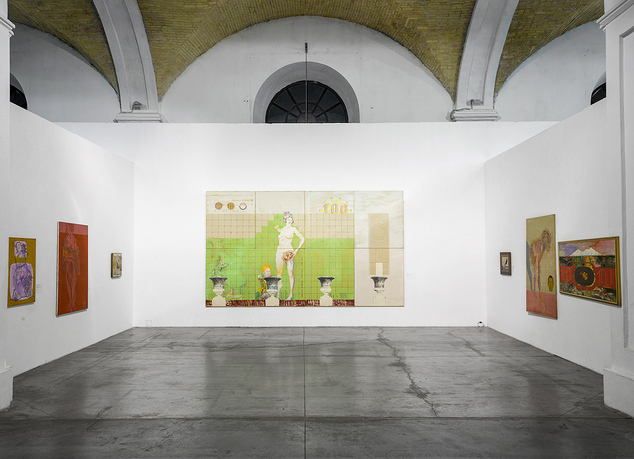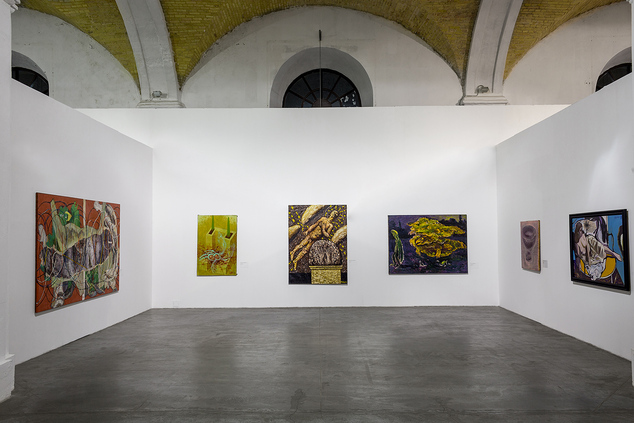Noble Assembly
9.10.2015
Woman - Forbes Ukraine
How did the Ukrainian collectors change over the past three decades
Art Kyiv Contemporary hosts "The Museum Collection. Ukrainian Contemporary Art 1985–2015. From private collections" exhibition until October 10 at "Mistetskiy Arsenal". 40 domestic art collectors show the works of 70 local artists from their collections.
Forbes has learned from project curators Alexander Solovyov and Igor Abramovich how to properly view the exhibition, what are the lessons to be learned from it, and where the exhibition can be seen in the future.
- How did you choose the works for the exhibition?
Igor Abramovich: We relied primarily on collector's opinion. There are those who has been collecting since the 1990s, so there is already a pool of artists assembled by itself: from "Picturesque Reserve" group, Marko Geiko, Alexander Dubovik, Matvey Vaisberg; the names are well known, they are the top artists. But the exhibition is not a museum collection. It is important to note: the works are coming from private collections, and this is a curatorial vision.
Alexander Solovyov: Our history of art collecting is almost simultaneous with the history of what we call contemporary art. Both are about 30 years old, it all started in the late 1980s.
The first wave of collecting was depersonalized, it was associated with corporate collections. The initial capital, transition to market economy — many banks and financial groups started to gather collections back then. And only a dozen years later the individual collectors emerged, who were collecting for various reasons, including prestige or status. And then came a realization that this is not just some hobby, it can become a matter of "love". There is a paradox: we complain that we haven't got a proper market, but on the other hand collectors indeed exist. We have 40 names, although the list could go on.
When we started working on the project we did not just take everything, we were choosing, we have always had a dilemma of choice. The same artist is well represented by several collectors, but "Mistetskiy Arsenal" has limited space. So we then lined up our curatorial vision. This is our vision of the historical slice, but that's not a history of art. Collector can collect hits, and the exhibition has a lot of them. But sometimes Oleg Golosiy's little works can be more important for the holistic picture than some large-scale things.
We do realize that contemporary art also includes installation and video. But did they become a norm for collecting? Is there a demand among collectors? No, for various reasons, including lack of understanding how to store such works, or how much to pay for them. "The Queen of the Fields" is, of course, a painting. Ukraine can and should be proud of it. And some graphics and sculpture as well.
It is very important that presented works are owned by domestic collectors. For so many of the works, especially the early ones, disappeared abroad and are not available.
Igor Abramovich: After the opening of the exhibition I received a letter from 74-year-old American collector who collected works of Yuri Solomko, Arsen Savadov, Alexander Gnilitsky, Oleg Golosiy. He asked wether we were interested in exhibiting works from his collection. Many artists did not even keep track of who was buying their works in the early 1990s.
- How is the exhibition structured? What is the right way to view it?
Alexander Solovyov: We have divided the exhibition into three periods; not just into decades, but by taking halves of each decade. Each period has its own specifics and priorities. Besides, we were interested to present the same artist in different periods. The artists were also going through creative metamorphosis: they went through a figurative period, then they switched to plastic abstraction, e.g. "Picturesque Reserve" group. Then some, Anatoly Krivolap for instance, went back to figurative art, fauvism, landscape. Some began experimenting with materials, like Alexander Zhyvotkov, at the junction of painting and relief sculpture.
- Did collectors taste change over time?
Alexander Solovyov: This exhibition is also a slice of demand among collectors. Changes are rather generational. Initially there was a craving for a certain circle of artists: Oleg Tistol, Arsen Savadov, Alexander Roitburd, Alexander Gnilitsky, Tiberiy Silvashi. But in the second half of 2000s, when a new generation of collectors came into being, an interest in younger artists appeared. And now after the first group of young artists came another one, whose art is conceptual, full of discourse and performance. Modern young artists put aesthetics over ethics. Many collectors feel the pulse of time and try to buy very young painters. This is also symptomatic and we wanted to hint on that, too.
- Is it possible to make a generalized portrait of Ukrainian collector?
Igor Abramovich: They are diverse. There is an older generation of collectors and there are the younger ones, and they are very different. It can be seen by the works they collect. The "old guard" collected all the best stuff early on. Young collectors are oriented more on young artists and on the recent works of famous ones. However, during the collecting process they start to go deeper, search, for example, for the early works of certain artists. Collecting becomes systemic. They are united by one thing: the love of Ukrainian art.
One of the objectives of the exhibition is to instill interest in collecting. There comes a lot of young people; maybe 25 years old but who has already succeeded. And many of them are beginning to be interested.
Alexander Solovyov: Collecting gives rise to other activities. This can be some new foundation that will support contemporary art. This is also a very important point. Sooner or later arises the question of where to store all these works. And, in fact, the way of all collections is to the museum.
- What is the further fate of the exhibition?
Igor Abramovich: Firstly, there will be a catalogue. We have gathered three times more works there. Plus, photos from the exhibition will be in it. We carry a lot of negotiations. We would like to take the exhibition to Kharkiv (to "YermilovTsentr") as well as to Lviv. And we want to take it abroad, to show it in even bigger scale.
Alexander Solovyov: Everybody should see it.




